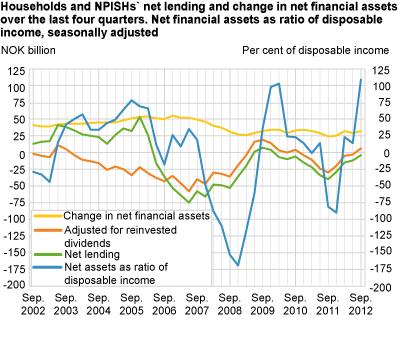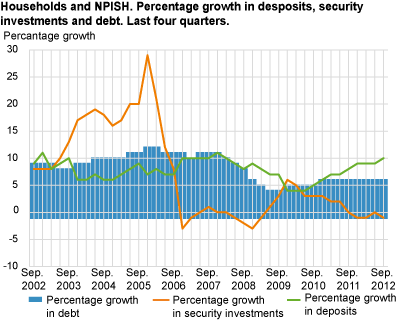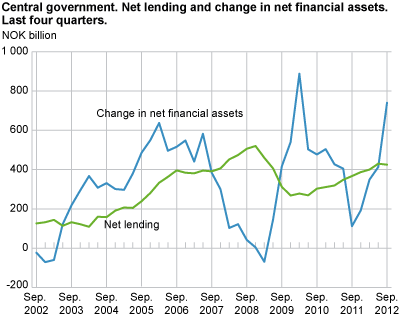Content
Published:
This is an archived release.
Households consolidate their position
Households have maintained the growth in their bank deposits and are continuing to sell securities. The debt growth has been high but stable in the six last quarters.
Households and non-profit institutions serving households increased their net lending by NOK 7 billion in the four quarter period to the third quarter of 2012. However, net lending was estimated at NOK - 4 billion during this period. Net lending has been negative since the first quarter of 2010.
The main picture is characterised by record high growth in bank deposits and net sales of securities. The growth in transactions in currency and deposits is summarised to NOK 78 billion in the last four quarter period. Households have simultaneously sold securities for NOK 6 billion. Deposits have increased every period from the fourth quarter of 2009, while the last four quarter period is the fifth period in a row with net sales of debt securities, shares and other equity.
Stable debt growth
The estimated annual growth rate for households’ total debt has been stable over the last six quarters and was 7.2 per cent in the third quarter of 2012. The growth in loans and other debt decreased slightly from the previous to the last four quarter period.
Household debt increased less than income in the third quarter of 2012. The quarterly seasonally-adjusted debt to income ratio - total debt as a percentage of disposable income - fell by 0.5 percentage points to 204.5 per cent at the end of the third quarter of 2012. However, debt figures were influenced by the revised institutional sector classification that was implemented in important source statistics from the first quarter of 2012. The new classification has induced a break in the time series for stock in the financial accounts at the turn of the year 2011, but this has not influenced the development in the debt to income ratio from the second to third quarter of 2012.
Substantial increase in State’s net financial assets
Central government’s net financial assets increased by NOK 740 billion over the last year to the end of the third quarter of 2012. The huge increase was highly affected by exchange rate developments in currency and securities markets. Central government’s holding gains amounted to NOK 315 billion in the last four quarter period. At the same time, net lending was NOK 425 billion, which is down NOK 4 billion compared to the previous four quarter period to the second quarter of 2012. Central government’s net financial assets were NOK 4 949 billion at the end of the third quarter of 2012. Of this, the market value of the Norwegian Government Pension Fund Global amounted to NOK 3 723 billion.
Local government’s debt increases
Local government’s net lending is estimated at NOK -20 billion in the four quarter period to the third quarter of 2012. This is down NOK 6 billion from the previous four quarter period and the fall is due to increased borrowing and declining financial investments. In the last four quarter period, local government borrowed NOK 35 billion compared to NOK 32 billion in the previous period. Total debt amounted to NOK 471 billion at the end of the last quarter. Net debt increased by NOK 20 billion in the third quarter to NOK 148 billion at the end of the quarter.
Net foreign assets continue to increase
Norway’s net foreign assets are estimated at NOK 2 848 billion at the end of the third quarter of 2012. This is an upturn by NOK 90 billion from the end of the second quarter. Norway’s net lending abroad was NOK 96 billion in the third quarter of 2012, which is up NOK 10 billion from the previous quarter.
| 2. quarter 2010 | 3. quarter 2010 | 4. quarter 2010 | 1. quarter 2011 | 2. quarter 2011 | 3. quarter 2011 | 4. quarter 2011 | 1. quarter 2012 | 2. quarter 2012 | 3. quarter 2012 | ||||||||||||||||||||||||||||||||||||||||||||||||||||||||||||||||||||||
|---|---|---|---|---|---|---|---|---|---|---|---|---|---|---|---|---|---|---|---|---|---|---|---|---|---|---|---|---|---|---|---|---|---|---|---|---|---|---|---|---|---|---|---|---|---|---|---|---|---|---|---|---|---|---|---|---|---|---|---|---|---|---|---|---|---|---|---|---|---|---|---|---|---|---|---|---|---|---|---|
| Financial assets | 6 854 | 6 797 | 6 997 | 7 232 | 7 133 | 7 353 | 7 329 | 7 784 | 7 806 | 7 958 | |||||||||||||||||||||||||||||||||||||||||||||||||||||||||||||||||||||
| Liabillities | 4 671 | 4 540 | 4 705 | 4 969 | 4 789 | 5 052 | 4 855 | 5 119 | 5 049 | 5 111 | |||||||||||||||||||||||||||||||||||||||||||||||||||||||||||||||||||||
| Net financial assets / net financial wealth | 2 183 | 2 258 | 2 291 | 2 263 | 2 343 | 2 302 | 2 473 | 2 665 | 2 757 | 2 848 | |||||||||||||||||||||||||||||||||||||||||||||||||||||||||||||||||||||
| Change in net financial assets / net financial wealth | 83 | 75 | 34 | -29 | 80 | -42 | 172 | 192 | 92 | 90 | |||||||||||||||||||||||||||||||||||||||||||||||||||||||||||||||||||||
| Other changes | 12 | 13 | -53 | -110 | -13 | -135 | 67 | 59 | 7 | -6 | |||||||||||||||||||||||||||||||||||||||||||||||||||||||||||||||||||||
| Net lending | 71 | 62 | 87 | 81 | 93 | 93 | 105 | 133 | 86 | 96 | |||||||||||||||||||||||||||||||||||||||||||||||||||||||||||||||||||||
DefinitionsNet lending as defined in non - financial accounts ( capital account ) = Net lending as defined in financial accounts = Savings consist of non-consumed income and can be invested in financial or non-financial assets. If savings exceed non-financial investments, a sector has a surplus of funds and becomes a net lender to other sectors. In the financial transactions account, this means that the sector acquires more financial assets than liabilities. On the other hand, if savings are less than non-financial investments, investments have to be funded either by selling financial assets or incurring debts. Household investments in non-financial assets mainly reflect the purchase of new housing and fixed investments by unincorporated enterprises. They typically finance substantial parts of these investments by incurring debt in the form of loans. Net financial assets ( net financial wealth ) = total financial assets - total liabilities The financial balance sheet shows the financial position of a sector at the end of the reference period and is broken down into the categories of financial assets and liabilities. Insurance technical reserves, currency and deposits are the predominant assets held by households, while loans provided by financial corporations (banks etc.) constitute the main proportion of liabilities. Changes in net financial assets = net lending + other changes in assets , net The change in the financial balance sheet during the reference period is a result of accumulated financial transactions and other changes in assets. The latter category mainly reflects revaluations due to changes in market prices of financial instruments. |
Tables
Contact
-
Torbjørn Cock Rønning
E-mail: torbjorn.cock.ronning@ssb.no
tel.: (+47) 97 75 28 57
-
Jon Ivar Røstadsand
E-mail: jon-ivar.rostadsand@ssb.no
tel.: (+47) 21 09 43 69
-
Marit Eline Sand
E-mail: marit.sand@ssb.no
tel.: (+47) 40 90 26 74



